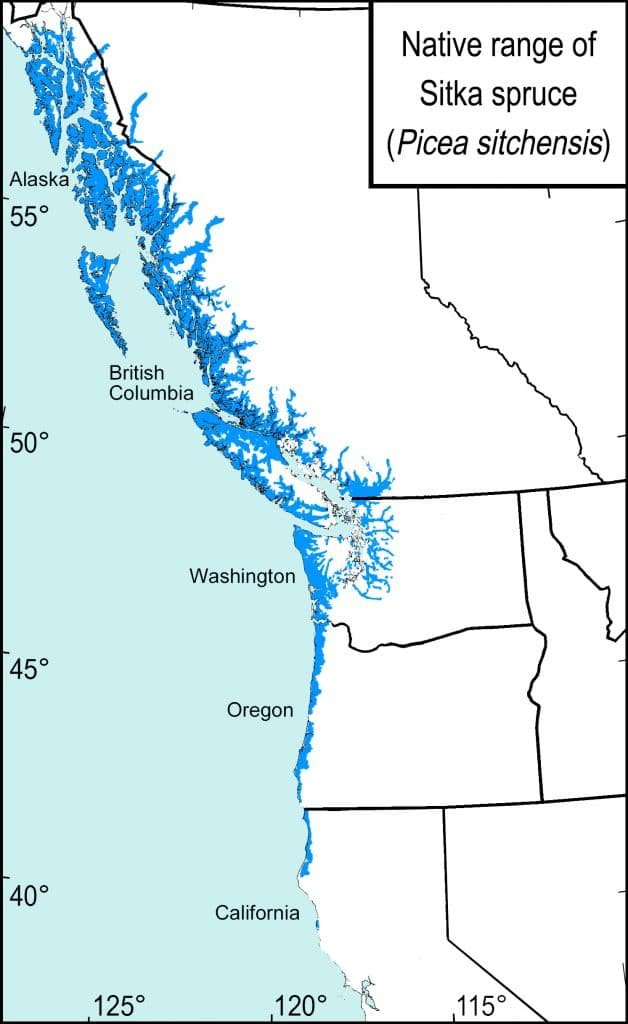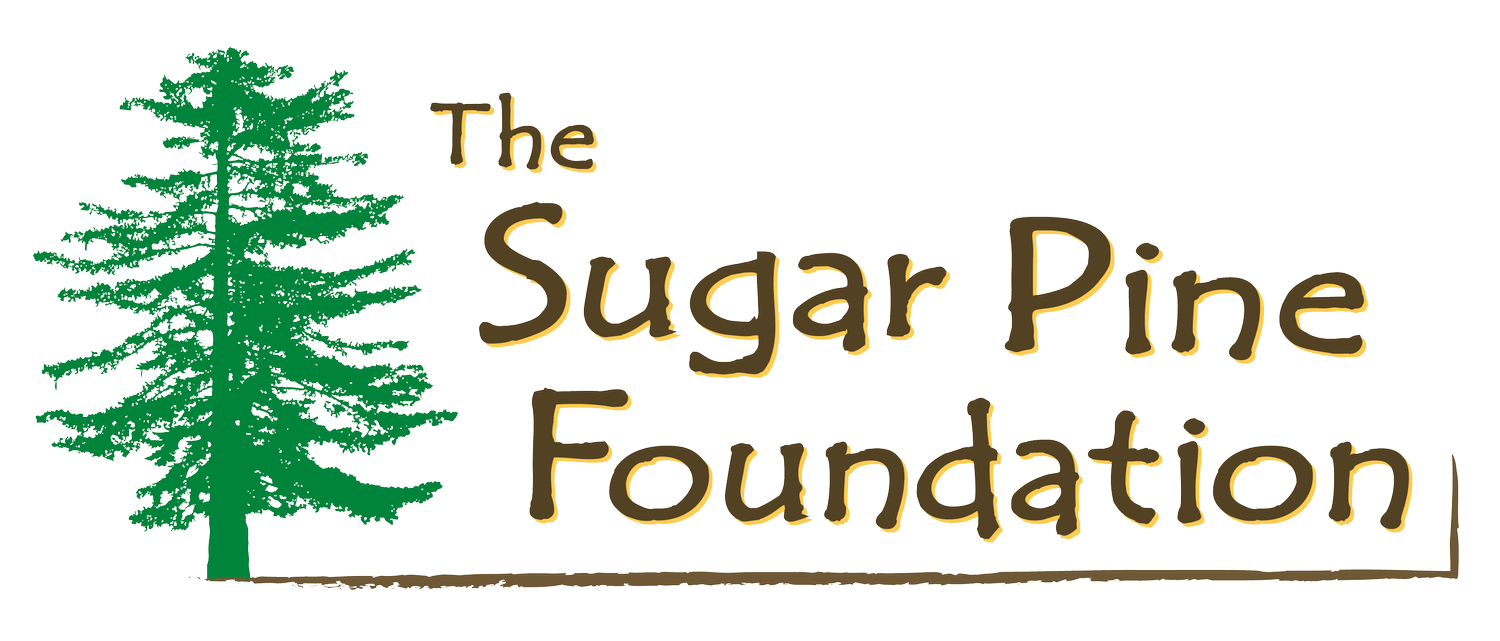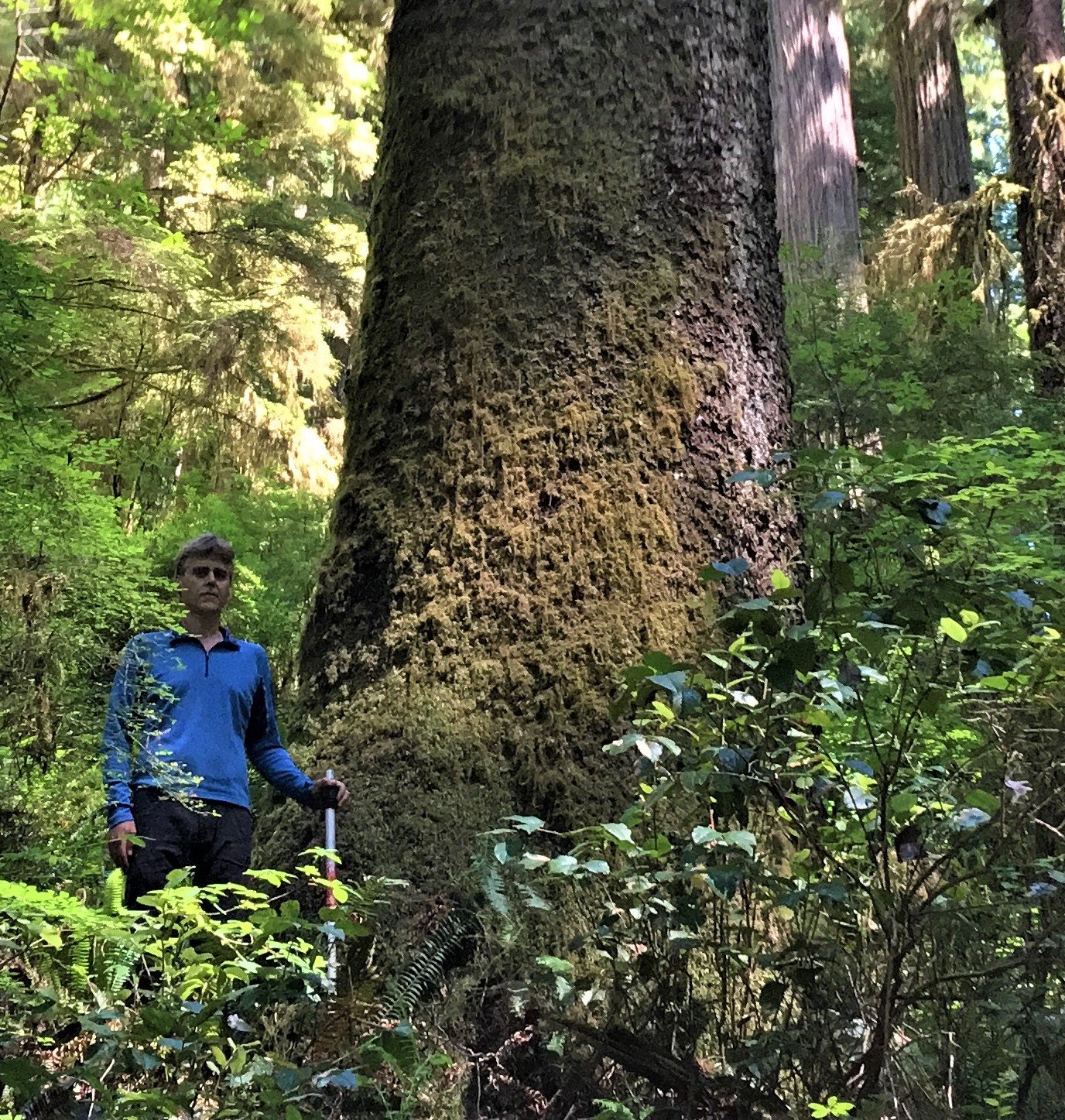Finding the Elusive 100m Non-Redwood With Michael Taylor and Steve Sillett
by Tressa Gibbard

When you are invited to join world famous tree hunter Michael Taylor on a tall tree expedition, you do not decline. Even if you do not know what you are in for, you accept the invitation and learn what you will be doing along the way.
Such was the case when I met Taylor in the California redwoods this summer. Since we were in the redwoods, I thought that we would be measuring coast redwood trees (Sequoia sempervirens). I was wrong.
Taylor and his collaborators have effectively grid searched and identified all of the tallest redwoods in Northern California. He is so intimately familiar with these trees, there is little left for him to discover.
What has kept Taylor, his friend Dr. Steve Sillett, and other big tree hunters up at night for over 20 years is their hunt for a non-redwood tree over 100m (328 ft) tall. To put this in perspective, the Statue of Liberty is only 305 feet tall. Another way to envision 100 m is to imagine ten two-story houses stacked on top of each other. Regardless of how you visualize it, 100 m is gargantuan.
Before they were decimated by industrial logging in the late 19th and early 20th centuries, the forests stretching from British Columbia to California were studded with 100-m-tall trees. Douglas-fir (Pseudotsuga menziesii) and Sitka spruce (Picea sitchensis) commonly reached such great heights but were systematically felled for their valuable timber. Finding a remnant, living, current day 100-m-tall specimen of either species has been a fruitless quest for tree hunters and scientists like Taylor and Sillett for so long that it has been likened to the search for the Holy Grail.
Unbeknownst to me, I had been invited to join this elusive, decades-long search for a mega-tall non-redwood. Our object for the day was to be a Sitka spruce growing in the midst of giant redwoods.
Not having spent a great deal of time in far-northern California or the coastal Pacific Northwest, I was not familiar with Sitka spruce. I was excited to see and learn about this species, but I did not know the first thing about Sitka spruce. I was rather embarrassed by my ignorance, so I chose not to advertise my naiveté.
The one thing that I did know going into this foray, was that I was going to be introduced to what Taylor calls “3-D hiking.”
I actually do enjoy a good bushwhack, so I was looking forward to the 3-D adventure of getting to our tree of interest.
Clambering up a steep hillside covered in five-foot-tall ferns and conveniently riddled with twining tree roots and enormous fallen logs covered in moss, huckleberries, and more ferns did not disappoint. I felt a bit like Alice in Wonderland as I followed the bobbing blue dot of Taylor’s shirt as he waded, scrambled, and leapt through the greenery with abandon and popped in and out of dense foliage ahead of me.
I could barely see where we were going but Taylor, with his superhuman tall tree perception, could always tell exactly where we were in relation to our prey: we were climbing a hill so that we could get a good view of the Sitka spruce he wanted to measure from above, rather than getting disoriented while trying to find the tree amidst towering ferns down in the gully where the tree stands.
Eventually we reached a good vantage point from which we could see two large trees shooting up from the bottom of the drainage below us. For my part, I could tell that they were not redwoods by their shape and bark. The trunks were rather slim and tapered, not massive, and the bark looked thin and scaly, not thick and reddish like redwood armature. Still feeling sheepish that I had never encountered this species before, I took Taylor’s word that we were looking at Sitka spruce.
Taylor instructed me to go down to the base of the larger tree with a prism and wait for him to find a good “window” from which he could shoot both the top of the tree and my prism by the base with his laser. I descended into the ravine – which was only slightly easier than going uphill in blinding foliage – and made my way to the bigger tree with some help from Taylor since he could see where I needed to go better than I could once I was enshrouded in the greenery. When I reached the tree and looked a couple hundred feet back up the hill to where I could hear his voice coming from, I could barely make out a tiny speck of blue – his shirt – amidst the vegetation. Then he vanished completely as he dove into the ferns and scampered higher up the vertical hillside.
A few minutes later, he shouted that he was in a good spot, but I could not see him. I scanned the hillside in the direction of his voice and finally saw a blur of movement from his waving hands.
He told me where to hold the prism and then he took his measurements with his laser range finder. The 3-D hiking master then bombed down to the tree; I had felt so clumsy floundering around in the ferns, but he made it down in a flash!
Together at the base of the tree, we proceeded to probe around the tree’s vaulted roots to find where the true ground level lay. To calculate the tree’s full height, we simply needed to measure the distance from where I’d held the prism to the ground level and then add that to Taylor’s laser reading. It all seemed straightforward yet, when Taylor added the measurements together, he fell silent.
I didn’t know why he was quiet, so I waited for him to say something.
Finally he blurted out, “Steve is going to puke.”
I didn’t know what he was talking about.
“Steve is going to puke,” he repeated.
“Why? What are you talking about? What did you get? How tall is the tree?,” I asked.
“It’s 100.1 meters,” Taylor said in utter disbelief.
“Ok, cool!,” I said, not understanding the significance of our finding. All I knew at the time was that Taylor, as a professional tree hunter, has found and measured the tallest trees in the world, so I trusted him completely: if he said the measurements were good and that he got 100.1 m, I figured that it must be true.
Dazedly, Taylor said something about how he had been searching for this tree for 20 years. I didn’t know what he meant at first but, as he gradually filled me in, I came to understand that no one had ever found a non-redwood over 100 m in modern times.

My first Sitka spruce, it seemed, appeared to be the tallest non-redwood ever measured. I had haplessly stumbled upon the Holy Grail of tall trees! Taylor was grappling with total shock and disbelief at what we’d just found. He was also desperate to share the news with Dr. Steve Sillett, his partner in record-breaking tall tree discoveries of nearly 30 years.
Taylor knew Sillett would be beyond excited by the news – and that he’d be the perfect person to verify our finding by re-measuring the tree.
It took Taylor a few anxious days to get through to Sillett but, when he did, Sillett was as enthusiastic as he’d predicted and was completely amped to go re-measure the tree. The two men made plans to revisit the tree and Taylor graciously invited me to join. I felt extremely lucky to be involved in such a historic discovery and I replied that I would definitely be there. In his odd, quiet way – and as if to affirm that I had made the right choice – Taylor assured me that, “Steve is a lot of fun.”
Sillett proved Taylor correct in more ways than one.
To be sure, Steve Sillett is an absolute bundle of energy and encyclopedic information about forest ecosystems. He is the Kenneth L. Fisher Chair in Redwood Forest Ecology at Humboldt State University, yet he is not above sharing what he knows about trees, lichens, mosses and all manner of plants with ingenues (like me). He is loquacious, expressive, and perpetually psyched on all things tree-related. Sillett peppers his sentences with words like “superlative,” “glorious,” and “astonishing.” He truly is a lot of fun – especially if you like trees!

With Sillett exuberantly leading the charge, we bashed, crashed, scrambled and stumbled our way to our prize Sitka spruce. Sillett took all of the measurements this time – including using his LiDAR-equipped iPhone to generate a 3-D image of the epiphyte-encrusted base of the tree. He spouted off the scientific names of mosses, liverworts, and lichens living on the tree’s trunk. As I later learned from reading Sillett’s 2021 article in the journal Forest Ecology and Management entitled “Comparative development of the four tallest conifer species,” Sitka spruce is a dominant structural component in coastal rainforests from British Columbia to Northern California and is notable for providing “arboreal habitats for old-growth associated species, especially epiphytes” in their spacious crowns and branches. As such, Sitka spruce is a major contributor to rainforest canopy biodiversity. Our specimen was appropriately cloaked in feathery live greenery from top to bottom.
The result of Sillett’s independent analysis of ground level and his laser measurements of the tree yielded a total height of 100.2 m. He hooted and hollered in ecstasy, and Taylor and I chimed in – for Sillett’s enthusiasm is contagious! We were all in high spirits – no longer in complete disbelief, but confident that we had actually found the long-sought-after 100 m non-redwood – as we made our way out of the woods and back to our cars.
Reflecting on the significance of our discovery at the vehicles, Sillett exclaimed, “This tree changes our understanding of tree biology!”
He was referring to the “fact” that of the four tallest conifer species in the world, Sitka spruce had always been measured as quite massive but not superiorly tall. The ranking of the tallest species had long been 1) coast redwood, 2) Douglas-fir, 3) Sitka spruce and 4) giant sequoia. Our specimen catapulted Sitka spruce to second-tallest conifer on Earth. For a variety of biological and historical reasons – including the fact that Sitka spruce are the shortest-lived of the tallest conifers (they grow fast but die young, rarely reaching 400 years old) and that they were logged off perhaps even more extensively than Douglas-fir – no one would have guessed that the elusive 100 m non-redwood would prove to be a Sitka spruce.
While it is slightly less surprising that we found this tree in Northern California’s “land of the giants” where premium growing conditions – abundant rainfall, well-drained soils, temperate winters and sites sheltered from wind – allow redwoods, Douglas-fir and Sitka spruce alike to reach their maximum proportions, it was nonetheless a completely unexpected honor and pleasure for me to be involved in this momentous discovery while I was visiting the redwoods. For me, it felt like a magical once-in-a-lifetime experience. As for Taylor and Sillett, I know that they make huge discoveries like this fairly often – and that is part of what keeps them going. In fact, after finding our tree together they proceeded to successfully identify three more of the tallest known Sitka spruce ever recorded in the same vicinity. The top four Sitka spruce officially measure in at 100.2, 99.1, 98.6 and 97.7 m. Such enormous trees are extra special because they effectively convert tons of carbon into biomass in a relatively short amount of time. For an important yet underappreciated species, there’s so much to love about Sitka spruce – including the fact that strong, light, and highly resonant Sitka spruce wood is used to produce gorgeous-sounding guitars, harps, violins, pianos and other instruments, though I don’t advocate cutting them down!
Regardless of their achievements, Taylor and Sillett are not content to rest on their laurels. They will always continue their quest to find, study and protect the tallest trees in the world – and I will always happily tag along and/or report on their big breakthroughs! But I absolutely cannot tell you where the trees are found, sorry! It is for their protection.
Deep thanks to Michael Taylor and Dr. Steve Sillett for including me in their endeavors, for their fine friendship and collegiality, and for allowing the Sugar Pine Foundation to share this remarkable story with our tree-loving fans and supporters!
1458 Mt. Rainier Drive, South Lake Tahoe, CA 96150 | (650) 814-956five | admin@sugarpinefoundation.org


